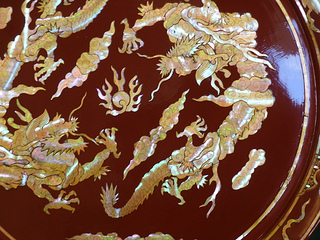Difference between revisions of "Raden"
From SamuraiWiki
Jump to navigationJump to search| Line 2: | Line 2: | ||
*''Japanese'': 螺鈿 ''(raden)'' | *''Japanese'': 螺鈿 ''(raden)'' | ||
| − | ''Raden'', or mother-of-pearl inlay, is a style and technique frequently used in [[lacquer]]ware decoration. It involves inlaying or otherwise affixing onto the lacquerware object cut sections of abalone or turban shell (''turbo marmoratus'', J: ''yakôgai'' 夜光貝), which have been ground to roughly 1mm in thickness, forming a thin shimmering rainbow-colored material. The technique is widely used throughout the East Asian region. | + | ''Raden'', or mother-of-pearl inlay, is a style and technique frequently used in [[lacquer]]ware decoration. It involves inlaying or otherwise affixing onto the lacquerware object cut sections of [[abalone]] or [[turban shell]] (''turbo marmoratus'', J: ''yakôgai'' 夜光貝), which have been ground to roughly 1mm in thickness, forming a thin shimmering rainbow-colored material. The technique is widely used throughout the East Asian region. |
{{stub}} | {{stub}} | ||
Latest revision as of 07:13, 6 October 2019
- Japanese: 螺鈿 (raden)
Raden, or mother-of-pearl inlay, is a style and technique frequently used in lacquerware decoration. It involves inlaying or otherwise affixing onto the lacquerware object cut sections of abalone or turban shell (turbo marmoratus, J: yakôgai 夜光貝), which have been ground to roughly 1mm in thickness, forming a thin shimmering rainbow-colored material. The technique is widely used throughout the East Asian region.
References
- "Cultural Treasures of the Ryukyu Kingdom: Ryukyuan Lacquerware," pamphlet, Urasoe Art Museum.
